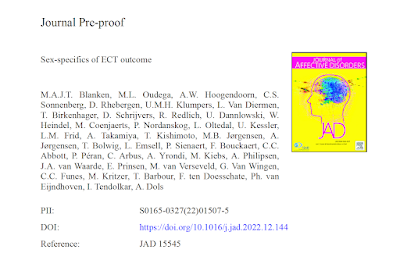ECT Equally Effective in Women and Men: New Study From GEMRIC
Out on PubMed, from international authors, is this study:
Sex-specifics of ECT outcome.
J Affect Disord. 2023 Jan 9:S0165-0327(22)01507-5. doi: 10.1016/j.jad.2022.12.144. Online ahead of print.PMID: 36632848
The abstract is copied below:
Objective: Electroconvulsive therapy (ECT) is the most effective treatment for patients with severe major depressive disorder (MDD). Given the known sex differences in MDD, improved knowledge may provide more sex-specific recommendations in clinical guidelines and improve outcome. In the present study we examine sex differences in ECT outcome and its predictors.
Methods: Clinical data from 20 independent sites participating in the Global ECT-MRI Research Collaboration (GEMRIC) were obtained for analysis, totaling 500 patients with MDD (58.6 % women) with a mean age of 54.8 years. Severity of depression before and after ECT was assessed with validated depression scales. Remission was defined as a HAM-D score of 7 points or below after ECT. Variables associated with remission were selected based on literature (i.e. depression severity at baseline, age, duration of index episode, and presence of psychotic symptoms).
Results: Remission rates of ECT were independent of sex, 48.0 % in women and 45.7 % in men (X2(1) = 0.2, p = 0.70). In the logistic regression analyses, a shorter index duration was identified as a sex-specific predictor for ECT outcome in women (X2(1) = 7.05, p = 0.01). The corresponding predictive margins did show overlapping confidence intervals for men and women.
Conclusion: The evidence provided by our study suggests that ECT as a biological treatment for MDD is equally effective in women and men. A shorter duration of index episode was an additional sex- specific predictor for remission in women. Future research should establish whether the confidence intervals for the corresponding predictive margins are overlapping, as we find, or not.
Keywords: ECT; Electroconvulsive therapy; Major depressive disorder; Phenotype; Predictor; Sex; Sex-specific.
The article is here.
And from the text:
Kudos to our GEMRIC colleagues for continuing to mine their dataset.







Comments
Post a Comment